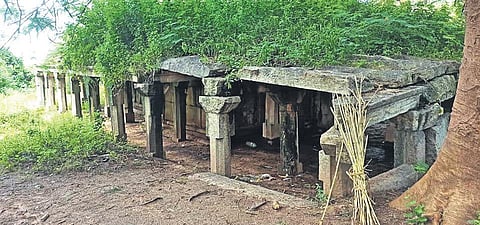

Our history textbooks are full of stories of royal sons killing fathers, brothers killing each other, murder and destruction. This is the history of Delhi, of many of the Sultans and Mughals. But elsewhere in India, there were great rulers who behaved with more honour and dignity and about whom we do not know much. One such dynasty was the Cholas, one of the longest ruling in the world, who were mentioned by Ashoka in the third century BCE.
The Grand Anicut or Kallanai was built by Karikala Chola between 100 BCE and 100 CE in Thanjavur District, and is one of the oldest water-regulatory structures in the world. It is a massive dam of unhewn stone across the Kaveri. A later Chola record from Tiruvaduturai refers to this construction as raising the banks of the Kaveri by Parakesari Karikala Chola. It was recently recognised as a World Heritage Irrigation Structure.
The famous seaport Kaveripattinam or Puhar was also built by Karikala. Apart from excellent maritime facilities, the port had facilities like stevedoring, customs clearance, storehouses, money exchange and so on. Horses were imported by sea in Puhar. Its greatness is testified to by Periplus of the Erythraean Sea, Ptolemy’s Geography, Pattinapalai and Silappadikaram. There were lighthouses for night navigation.
In the 10th century, after his elder brother and crown prince Adithya Karikala was assassinated and his father died, Chola prince Arulmozhivarman did not ascend the throne. His uncle was crowned instead. It was only after his uncle Uttama Chola’s death in 985 CE that Arulmozhi became the king and was given the title Rajaraja I or ‘King of Kings’. This was a very noble deed at a time when people were killing each other to become the king. Rajaraja built the great temple with a tall vimana or tower in Thanjavur. It is one of the greatest monuments of India.
His son Rajendra Chola was declared heir apparent and formally associated with his father in the administration of the Chola Empire in the final years of Rajaraja. When Rajaraja died in 1014, Rajendra was crowned king. He was a great warrior and conquered the Rashtrakutas and the Western Chalukyas. With the Cholas’ powerful maritime fleet, Rajendra conquered Southeast Asia. In 1017, his navy captured a major part of Sri Lanka. In 1018, he conquered the Pandya and Chera territories and captured the islands of Maladvipa (Maldives), Lakshadweep and Manakkavaram (Nicobar).
In 1019, he defeated the rulers of Odisha, Bihar and Bengal and captured north Karnataka and southern Maharashtra. He is said to have been welcomed by the local people for he brought good rule and administration.
From Chhattisgarh, he split his forces into two and sent one towards the Ganges in the north and the other to the northwest. Few people are aware that Rajendra Chola sent his army to assist his friend Paramara Bhoja of Malwa in Madhya Pradesh, which would likely have been to fight the invasion of Mahmud Ghazni and relieve the kingdoms that had fallen victim to the invasions. An inscription from Kulenur in Karnataka confirms that there was an alliance between Bhoja of Malwa, Rajendra Chola and Gangeya of Kalachuria.
In 1025, he invaded Burma, Thailand, Malaysia, Indonesia, Cambodia and Vietnam with his navy. He defeated the Sri Vijaya kings of Indonesia and was hailed as Kadarakonda Cholan (Malaysia was known as Kadaram). The Bay of Bengal came under his total control.
Rajendra Chola did not destroy cities. Instead, he asked each king of the Gangetic region to bring a pot of Ganga water to his capital Gangaikonda Cholapuram near Thanjavur, and built the Chola Ganga Tank to hold the sacred water. He also built a beautiful temple at Gangaikonda Cholapuram in honour of Siva. Here his humility is outstanding: he made this temple shorter than the one at Thanjavur out of respect for his father. His descendant Rajaraja II built the Airavateshwara temple at Darasuram. All the Chola kings built several beautiful temples in and around Thanjavur.
Rajendra was possibly the greatest conqueror in India. He used his navy to great effect to conquer lands outside India. Unfortunately, not much is known about shipbuilding in ancient India, except from the Yuktikalpataru (c. 12th century). The Agramandira class of ships, with cabins fitted towards the prows, were used in naval warfare. They were long, thin and of high speed. Chola inscriptions indicate that troops were transported by ships for battle at sea and on land. Periplus of the Erythraean Sea (first century CE) mentions three kinds of craft used in the south: light boats for local traffic, larger vessels of greater carrying capacity and huge ocean-going vessels for transporting goods, horses and men. Ships were built out of timber—blackwood, mango, khadira, silk cotton, cedar or teak. The planks of the hull were stitched together with palm fibre. The ship was navigated with a mast. Square or semi-rectangular sails were used, as depicted in the Ajanta paintings. Pirate ships also sailed the seas and a strong navy was essential to ward them off.
The Cholas brought in a single, centralised government for their empire. They had a well-planned army consisting of elephants, cavalry, infantry and navy. Land revenue and trade tax were their main sources of revenue and they issued coins in gold, silver and copper. They maintained hospitals for their people. The merchants organised themselves into guilds both in India and abroad and traded as far as China.
The art and architecture of the Cholas, especially stone and bronze sculpture, is incomparable. The dynasty gradually declined in the thirteenth century, although one branch was still ruling over the Philippines till 1565. It is necessary to teach every Indian about the great Cholas who once ruled over land and sea.
Nanditha Krishna
Historian, environmentalist and writer based in Chennai
(nankrishna18@gmail.com)